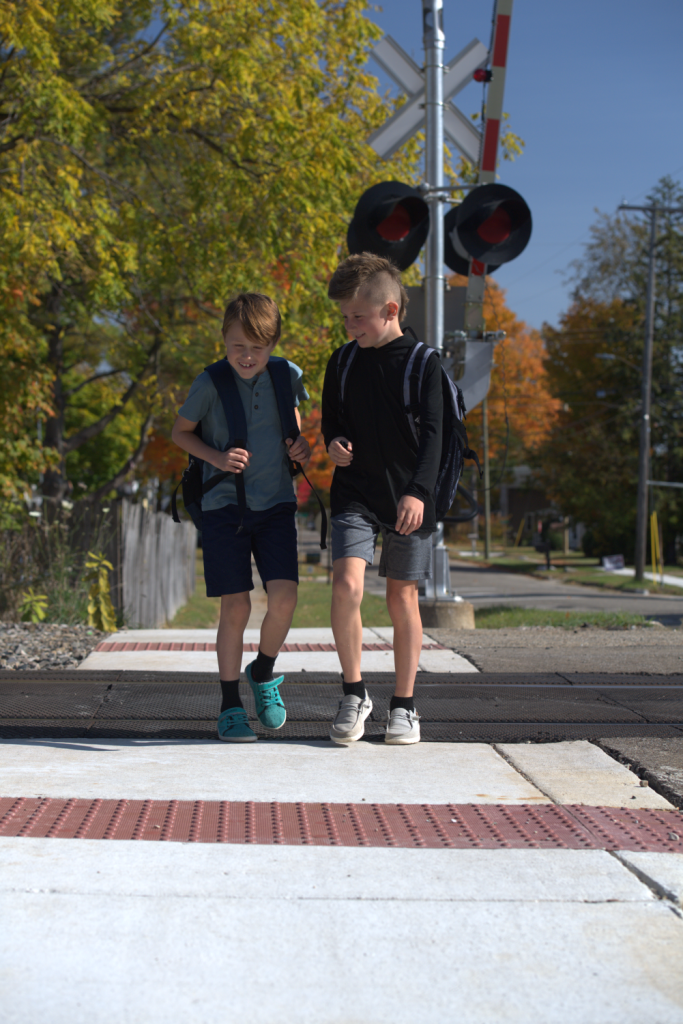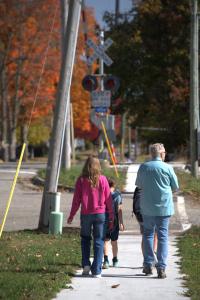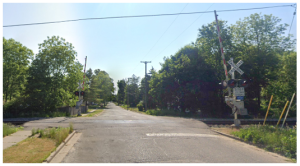
Every active transportation infrastructure project has its own unique challenges when determining options for walkers, bikers, and rollers. This can especially hold true when a community is interested in working along a corridor that includes roads and a railway.
In the City of Charlotte’s Safe Routes to School (SRTS) project, they found they needed to modify an existing at-grade railroad crossing to accommodate people using active transportation methods.
While railroads are primarily regulated at the federal level, the Michigan Department of Transportation (MDOT) Office of Rail works to ensure that Michigan’s rail system is safe for the public and has dedicated staff who understand the nuanced challenges involved in projects involving railways. They can explain processes and provide guidance and advice toward potential solutions appropriate for active transportation projects. Whenever a new or modified grade crossing is needed within the public right of way, Rail Safety’s role is to investigate the
safety impacts of the proposed or modified crossing and to issue a legal order establishing the requirements for the work.
“MDOT serves as the regulatory authority throughout the state over all public highway railroad grade crossings, shared use pathway grade crossings, and any sidewalks that may be within public rail right of way,” said MDOT Rail Safety Manager Kris Foondle.
When working with the Office or Rail Safety the first step is to fill out the “Notification of Proposed Project Involving a Public Rail Crossing” also known as Form 1425.
“Completion and submittal of Form 1425 is the starting point from where the Office of Rail Safety can work on the project’s behalf and ensure that the railroad company is responsive,”
explained Foondle.
MDOT Office of Rail will also determine whether a Diagnostic Study Team Review (DSTR) is required for the project.
“The DSTR process is a meeting between a road authority representative, a railroad representative, and our rail safety inspector. At this meeting, the group goes over what’s being proposed” explained MDOT Local Grade Crossing Analyst Alexis Louth. “That way everybody involved can get on the same page to understand the project and develop an agreement or consensus between all parties to move forward with the identified results, such as extending the crossing to accommodate the trail or sidewalk crossing over the rail.”
Several aspects of Charlotte’s Henry Street crossing made for a straightforward process. Due to a sidewalk being a legally permissible use of the right of way on public roads, and the presence of an existing sidewalk facility on the north side of the crossing, it was determined that no DSTR was required. If a DSTR was required, the agreement becomes a legal order by the State of Michigan. Without the need for a DSTR and because there was federal/state funding involved, the Office of Rail was able to help the City of Charlotte by coordinating directly with the railroad company since they have standing Master Agreements for crossing work with most railroad companies.
Regardless of what kind of crossing is being pursued, it’s important to recognize when the scope of any project will impact a railroad and reach out to the Office of Rail for assistance as early in the planning process as possible.
“Reaching out to the Office of Rail ahead of time allows communities to understand and navigate challenges with more ease,” said Foondle.
The Office of Rail also has access to industry design standard costs which help in the review of proposed estimates of the scope of work in the rail right of way. Further, when federal/state funds are being used, the Office of Rail can provide project authorization and administration for delivery of the special railroad force account work during construction.
Force account work is needed because the railroad is responsible for the surface at the tracks and coordination will be needed between the rail portion of the work and the portions of the sidewalk or pathway work approaching the track for which the community is responsible.
“It never hurts to reach out to the Office of Rail and the rail company ahead of time. Early introductions allow for a smooth process,” said Foondle. “Reaching out to the Office of Rail ahead of time allows communities to understand and navigate challenges with more ease.”
The most common obstacle to rail projects are misunderstandings regarding property arrangements, or when real estate arrangements are not made in advance. And, legal permission is required when active railroad corridors are involved.
“They might not realize that property acquisition may be required or that an adjustment to an existing easement may be necessary,” explained Foondle. “To ensure there is a legal right to
cross the tracks, they have to work with the railroad.”
If these obstacles are not addressed and agreements are not made early, it could cause significant delays to the project’s timeline.
Additionally, it is worth noting that while a project to extend or create a crossing facility may not be paid for by the rail company, with the SRTS Major Grant covering the costs of constructing new or extended crossing facilities, any time a crossing has to be replaced or maintained in the future it will be at the railroad company’s expense. Understanding this perspective may help stakeholders better understand considerations from rail companies when working to find consensus.
There are various benefits to working with the Office of Rail. The assistance of their staff and their ability to act as a liaison between the state, the community, and the railroad company can help a community see through the weeds.

With his work across the state, Foondle sees the benefit of developing and continuing relationships between communities, MDOT, and rail companies. And, in the City of Charlotte,
relationships were bolstered.
“The outreach to the department for assistance and guidance on the right way to proceed with this project was valuable both for the community, MDOT, and the railroad. Because with that outreach, we were able to establish better working relationships and appropriate contacts,” said
Foondle.
A community should not worry or avoid a project aspect simply because it involves rail.
“Don’t run screaming into the hills worried. Reach out right up front to your Transportation Alternative Program or Safe Routes to School grant coordinators and directly to the Office of
Rail. We can advise you on the front end,” advised Foondle.
“I’m passionate about my job and about working with communities, because it is essential to provide the equipment and information which allows people to make good decisions,” said Foondle. “I believe that any incident at a grade crossing is preventable with appropriate engineering and education.”
Safety resources and ways to reach the MDOT Office of Rail:
Project Impact
This project installed new ties and rubber flangeway with asphalt surface to accommodate the SRTS sidewalk project on the south side of Henry Street between Lincoln and Pearl in addition to filling gaps in their city-wide network of sidewalks.
- MDOT SRTS Total Infrastructure Budget: $ 1,828,489.00
- Rail section: $29,445.00
This project was made possible through the continuing collaborative efforts of the City of Charlotte, Charlotte Public Schools, St. Mary School, Eaton County Road Commission, Michigan Fitness Foundation, Michigan Department of Transportation, and Federal Highway Administration.


